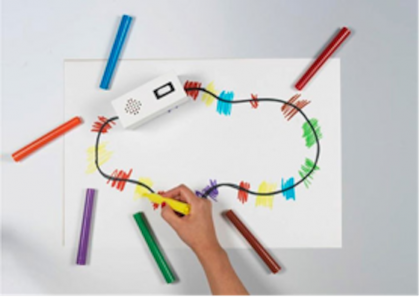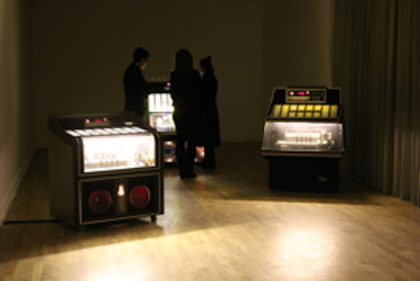Juke Box Meets Tate Britain
Interview by Chinami Sakai (Assistant Curator, Early Years & Families) with artist Yuri Suzuki and researcher Kiki Claxton
Yuri Suzuki is a sound artist, designer and electronic musician who produces work that explores the realms of sound through exquisitely designed pieces. Interaction by people has been a key element to many of his previous installations and exhibitions, which led him to be invited to design a number of workshops and events for children and families.
I originally met Yuri at a workshop he designed for families at the Serpentine Gallery a couple of years ago entitled Colour Chaser, where a number of miniature vehicles followed black lines drawn by participants, and made funny electric sounds according to the colours chosen surrounding the lines.

© Hitomi Kai Yoda
Colour Chaser, Yuri Suzuki
For the launch of the new Learning Gallery at Tate Britain, Yuri devised Juke Box Meets Tate Britain, an immersive display of a changing and expanding sound archive - a collection of vinyl records, cut by the artist himself one by one. The sonic materials held in three juke boxes are inspired by the new collection display at Tate Britain, the BP Walk through British Art, representing 500 years of British Art history, and will grow throughout the duration of the display through visitors’ interaction. Below is an excerpt from an interview with the artist, and with the researcher who worked on the project with me, along with some of my own observations.

© Tate
Jukebox meet Tate Britain by Yuri Suzuki, 2013
Can you tell me about your practice as an artist?
My practice is all about sound and physicality. I think vinyl records have a special quality that no other medium has - it was the first media invented to save sonic data (and is still the media used by professional DJs today), it is something you cannot produce or duplicate at a domestic level and it is an object that many children have never touched or experienced before.
There are many reasons why I have worked a lot with the media through my own practice, but most importantly for me, it is the only media that holds data as physical material. You cannot lose the data unless you physically destroy it. This aspect really interests me and that is why much of my practice is to do with creating some sort of archive through vinyl records, translating digital files to physical objects.
Sound has always been an important element of your practice, and you also talk particularly about the idea of ’sound in the museum’ - could you tell me a bit more about this?
As children, we were always told to be ’quiet’ in a gallery or a museum. On the other hand, in clubs, concert halls or even domestic environments, there are limitless opportunities to hear sound and music. This is why I am particularly interested in presenting my work in museums and gallery environments.
I have noticed that because we expect museums to be quiet places, our sense of sound gets sharper than usual there - so that sound works become somewhat more unexpected and even more intriguing. So I think the museum is the best place to present sonic-based projects!
The ’Juke Box Meets Tate Britain’ project launched the new Learning Gallery space at Tate Britain. Was there anything in particular you considered due to the nature of the project being a display (as opposed to an event or workshop) within the parameters of a Learning programme?
I think I am anyway interested in the interactive quality of my installations and exhibitions - something being built or constructed through people’s interactions, and often therefore over a particular duration.
For such projects, I think it is really important to think about a good solid structure, within which there is room for visitors to be creative. Otherwise there is no control, and no substantial interaction happens. So when I started thinking about the project for the Learning Gallery, I imagined there would be absolutely all age ranges of people visiting for different amounts of time, and that it was my responsibility to provide a structure so that any scenario of experience ended up somewhat positive and aesthetically pleasing (from a 2 minute interaction, to an hour-long contemplation).
Yes, I have actually noticed a great variety of experiences and dynamics in the space - the juke boxes have been a great starting point for conversation with visitors of all ages. How did you come up with the idea of placing juke boxes in the space?
Related to the idea of ’sound in museums’, I was thinking about a space where people could listen within a museum. I think the juke box is a great piece of equipment to enable people listen to music or sound, because you cannot skip to the next song or stop listening half-way through a track. Nowadays, people skip as soon as they get slightly bored when listening to something on an MP3 player. But when you are forced to listen to a full piece, you may notice something you really like but that you hadn’t heard before.
______________________________________________________________________________
Since its opening, the most brilliant thing to see happening in the space for me is the diversity of experiences that different visitors have, and the quick shifts and layers of multiple dynamics being created within the space - while an old couple dancing to Millie’s ‘My Boy Lollipop’ in one corner draws more visitors into the space, a father of a toddler trying to work the mechanism of a juke box plays out in the other corner. I have observed many teenagers enjoying browsing the play-lists, and a lone visitor writing something in their notebook (perhaps a poem?), inspired by a reading of one of Paul Nash’s letters.
Kiki Claxton, an artist (of collective FLAG) and Casual Learning Assistant at Tate who contributed extensively to the research process of the sound archive, noted the following about her experience of researching files and spending time in the space:
Juke Box Meets Tate Britain shifts the gallery from a place of insular experience (where you listen to something with headphones, for example), to enabling you to share that particular moment you are experiencing with others. When first embarking on the research, I realised this could be a piece of work that people of all ages could interact with and relate to because sound is something you hear everywhere and are unable to hide from.
(...) I knew Juke Box Meets Tate Britain could leave an impression on visitors and enable them to view art in a different way, which left me with the challenging task of finding sound elements, be it music, sound clips, letters, readings, interviews and much more - to add another dimension to the work, and for the participant to learn something new about the work (which is never one-sided). The research ranged from finding readings of ’A Midsummer’s Night Dream’ evoking Henry Fuseli’s work about Titania and Bottom, to discovering that Damien Hirst directed Blur’s ’Country House’.
Spending time in the space, you see participants getting a sense of nostalgia from the machines, or from a song they have not heard for a while and telling others about their story. Toddlers are captivated by the colourful machines, watching the records change at their height.
(...) Through working on this project, I have learnt an incredible amount about multiple pieces of art from all eras, and I can now safely say I will experience art on a whole new level.
What I’ve enjoyed seeing in Juke Box Meets Tate Britain is that the majority of families with young children who come into the Learning Gallery have been led by Tate staff to visit the space as part of the family programme, which gives them confidence and security to interact with the display together as a family, while other audiences just wander in, having no idea that it has been programmed by the early years and families team. I believe this could become a unique strength of the new Learning Gallery - that it naturally creates a great mixture of audience groups, and therefore generates interactions amongst and between audiences. Kiki also noted an encounter she had with an elderly visitor talking to a child from another family "I remember these...". If the display is creating dialogues like this, a project in the Learning Gallery such as Juke Box Meets Tate Britain could be a unique model of unexpected intergenerational learning that would otherwise not occur.
Related links:
http://yurisuzuki.com/
www.tate.org.uk/JukeBox
www.tate.org.uk/whats-on/tate-britain/daily-activities/juke-box-meets-tate-britain-audio-recording-sessions-families
http://www.flagcollective.org/


No comments added